4 types of brand extensions (with examples)
From adding new product variants to introducing brand-new categories, brand extensions take a number of different forms.
Line extension
Line extension involves extending a brand by adding and launching new variants or versions within an existing product category. For example, CRG worked with a popular cookie manufacturer to identify new flavors that would be desirable to customers. Similarly, CRG worked with a beverage manufacturer to identify the most promising new flavors to extend their existing product line.
Product extension
Product extension, also known as category extension, involves leveraging the brand name to enter an entirely new product category. Usually, this category is related to or complementary to the existing brand offering. Colgate, for example, produced toothpaste, then extended into toothbrushes and floss – a different but related category complementary to the original product. CRG has assisted with a number of product extension efforts, including helping a baked goods brand extend into the snack food category and helping a popular restaurant brand build a presence in grocery.
Lifestyle extension
A lifestyle extension is when a brand extends its offering in ways that align with the lifestyle of the target audience. These extensions should align with both the brand’s core values and the preferences, interests, and drivers of the brand’s existing customers. For example, CRG recently worked with a popular fictional children’s character to explore how the brand could extend into food and beverage. Other examples of lifestyle extensions include musician Rhianna’s brand extension into the beauty category and Lululemon’s extension into branded community events centered around health and fitness.
Consumer segment extension
This form of extension is when a brand targets a new consumer segment by adapting its messaging, offering, and packaging to appeal to that new segment. Nivea’s introduction of Nivea for Men – a range of skin care products packaged to appeal to a male market – is a great example of consumer segment extension. The product offering is essentially the same, but with a few minor tweaks, they captured an entirely new market.
3 proven strategies and tips for successful brand extensions
Successful brand extension is a fine art that relies on a deep understanding of audience and market potential, and a realistic awareness of how your brand is perceived. To carry out a successful brand extension, keep these key strategies in mind:
Understand the market
The first step when embarking on a brand extension is to conduct thorough market research. Research should aim to identify the viability of the proposed extension relative to market demand and target audience preferences. Market research should be carried out throughout the development lifecycle to refine both the product/service and messaging.
Maintain brand consistency
Any potential brand extension must be aligned with the brand’s core values and identity and should feel like a natural fit that reinforces the brand’s reputation, rather than diluting it. Brand dilution can be caused by overextension when a brand extends too far into categories that appear unrelated to its original identity.
Test and iterate based on customer feedback
Throughout the development process, new brand extensions should be regularly tested and iterated based on customer feedback. Be sure to partner with a vendor who can carry out agile market research with a short turnaround time for quick, informed strategic decision-making.
How to use predictive research when creating your brand extension strategy
Predictive research is the best way to ensure a successful brand extension initiative. Not only does it deliver the accurate data you need to drive strategic decision-making, but it also helps surface hidden winners – breakthrough, innovative ideas that are likely to score as “high risk” in traditional surveys.
Unlike traditional research methods, predictive research leverages the collective judgment of your target audience to predict future trends, consumer behaviors, and preferences, drawing on the audience’s tacit knowledge of how they believe others will behave to mitigate the effects of bias.
With predictive surveys and prediction markets, you can test early-stream brand extension concepts, products, and messaging, and optimize and iterate according to your results, significantly enhancing your chances of success upon launch.
Confidently expand your brand with CRG Predictive Intelligence
For over a decade, CRG Predictive Intelligence has been helping insights professionals and marketers optimize their decision-making for unprecedented strategic advantage. Whether you want to add a new variant or conquer an entirely new category, with CRG’s advanced HUUNU platform you can expand your brand with confidence, leveraging crystal-clear insights to make every move the right move.
Find out more about how CRG can assist you in developing a winning brand extension strategy by getting in touch with our team today.








